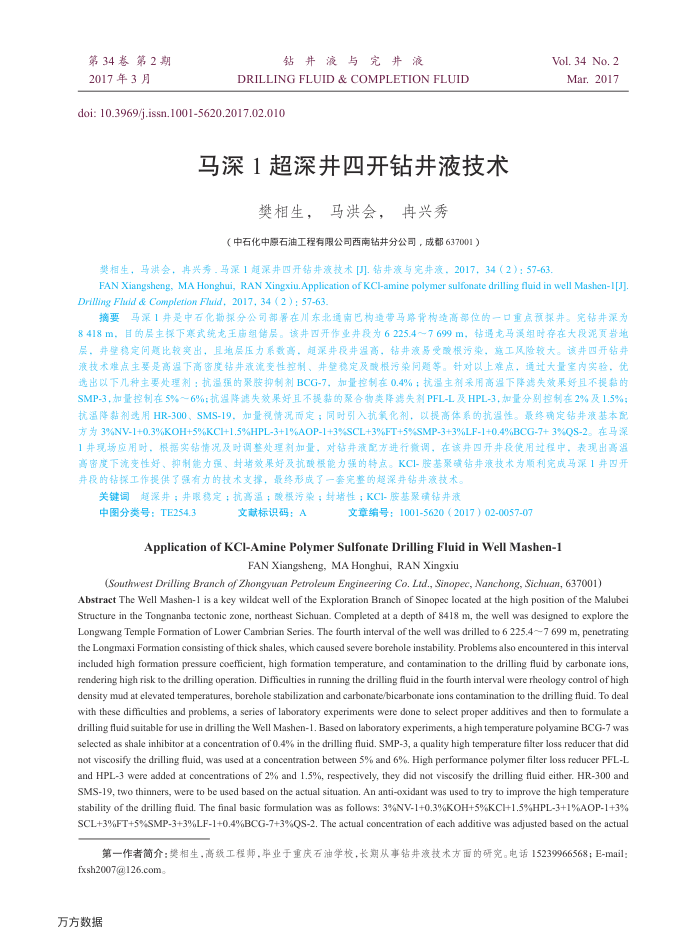您当前的位置:首页>论文资料>马深1超深井四开钻井液技术
内容简介
 第34卷第2期 2017年3月
第34卷第2期 2017年3月井液
钻井液与
究
DRILLINGFLUID&COMPLETIONFLUID
doi:10.3969/j.issn.1001-5620.2017.02.010
马深1超深井四开钻井液技术
樊相生,马洪会,冉兴秀
(中石化中原石油工程有限公司西南钻井分公司,成都637001)
樊相生,
与进会
FANXiangsheng Driling Flrdd
摘
中图分类号:
前
TE254.
四开钻井液技术钻井液与完井液,2017,34(2):57-63
Vol.34 No.2 Mar.2017
pplication of KCl-amine polymer sulfonate drilling fluid in well Mashen-I[]]
钻井速关
升朝
站并
文献标识码:
文章编号
1001-5620 (2017) 02-0057-07
Application ofKCl-AminePolymer SulfonateDrillingFluid inWell Mashen-
FAN Xiangsheng,MA Honghui, RAN Xingxiu
(Southwest Drilling Branch of Zhongyuan Petroleum Engineering Co. Lid., Sinopec, Nanchong, Sichuan, 637001)
Abstract The Well Mashen-1 is a key wildcat well of the Exploration Branch of Sinopec located at the high position of the Malubei Structure in the Tongnanba tectonic zone, northeast Sichuan. Completed at a depth of 8418 m, the well was designed to explore the Longwang Temple Formation of Lower Cambrian Series. The fourth interval of the well was drilled to 6 225.4~~7 699 m, penetrating the Longmaxi Formation consisting of thick shales, which caused severe borehole instability. Problems also encountered in this interval included high formation pressure coefficient, high formation temperature, and contamination to the drilling fluid by carbonate ions, rendering high risk to the drilling operation. Difficulties in running the drilling fluid in the fourth interval were rheology control of high density mud at elevated temperatures, borehole stabilization and carbonate/bicarbonate ions contamination to the drilling fluid. To deal with these difficulties and problems, a series of laboratory experiments were done to select proper additives and then to formulate a drilling fluid suitable for use in drlling the Well Mashen-1. Based on laboratory experiments, a high temperature polyamine BCG-7 was selected as shale inhibitor at a concentration of 0.4% in the drilling fluid. SMP-3, a quality high temperature filter loss reducer that did not viscosify the drilling fluid, was used at a concentration between 5% and 6%. High performance polymer filter loss reducer PFL-L and HPL-3 were added at concentrations of 2% and 1.5%, respectively, they did not viscosify the drilling fluid either. HR-300 and SMS-19, two thinners, were to be used based on the actual situation. An anti-oxidant was used to try to improve the high temperature stability of the drilling fluid. The final basic formulation was as follows: 3%NV-1+0.3%KOH+5%KCI+1.5%HPL-3+1%AOP-1+3% SCL+3%FT+5%SMP-3+3%LF-1+0.4%BCG-7+3%OS-2. The actual concentration of each additive was adjusted based on the actual
第一作者简介:类相生,高级工程师,率业于重庆石油学校,长期从事钻井液技术方雷的研究。电话15239966568;E-mail:
fxsh2007@126.com。万方数据
上一章:一种新型低密度矿渣固井液
下一章:抗高温超分子降滤失剂的合成及性能评价